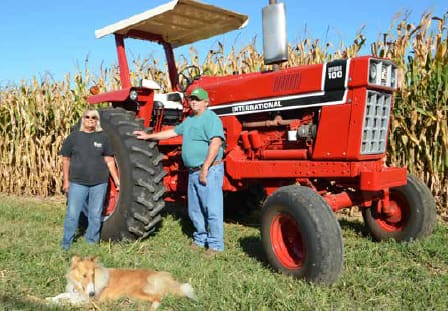“In the last twenty years, there’s more green countryside over the winter than ever before,” says Glen Krall. “Whole farms are green now.”
Conservation from the beginning
Glen and Linda Krall, who farm in Lebanon County, Pennsylvania, contribute to that green countryside. These experienced crop farmers have been farming since 1983, and currently grow crops on 800 acres while custom farming 300 additional acres. Their crops provide feed for the cattle on their son’s dairy farm.
From the start of their crop farming enterprise, Glen and Linda have engaged in a variety of conservation measures.
The Kralls’ operation is close to the Snitz Creek, which feeds into the Swatara Creek, to the Susquehanna River, and eventually, the Chesapeake Bay. Proximity to these bodies of water requires carefully planned conservation projects and attention to farming practices.
How it is done
The Kralls accomplished their early conservation projects, including stream bank fencing and the first manure storage projects, through the county conservation district. Their more recent projects utilized the U.S. Department of Agriculture’s EQIP (Environmental Quality Incentives Program).
As part of their nutrient program for crops, the Kralls use dairy manure from their son’s farm and imported poultry manure, testing both types for nutrient content prior to application. They also test the soil to ensure nutrients are applied at the appropriate rate. Instead of applying nitrogen at the beginning of the growing season and risk losing it in rain, they side dress corn with liquid nitrogen in late June.
To preserve the nutrients stored in poultry manure, Glen and Linda constructed a covered hoop building. They plan to construct a similar structure at their son’s dairy farm for solid manure storage.
The Kralls also plant cover crops. After harvesting corn silage, they apply manure and plant rye. In spring, some rye is chopped for ryelage, and the rest is burned down prior to planting corn and soybeans. The Kralls practice both no-till and minimum till on their operation, with some minimal light disking when necessary to knock down cornstalks. They also combine their own rye for seed.
Continued innovation
Looking forward, the Kralls plan on expanding their operation, acquiring new equipment and testing new environmentally sustainable practices on their operation. They believe keeping up with modern technology will help grow their operation and conservation practices.
“The technology in equipment today is different compared to a few years ago,” says Linda. “It can tell you which parts of fields are producing better, then tell you how much fertilizer it needs.” And although they don’t have the absolute latest in technology, Linda predicts that technology will be one of their next investments with their financial partner, Horizon Farm Credit.



